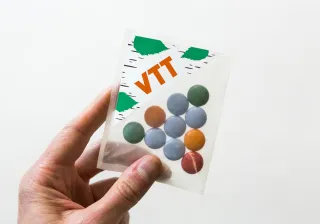VTT and LUT University alongside with Finnish companies have developed a method and guidelines for evaluating and communicating on the carbon handprint of products. The carbon handprint describes the positive climate impacts of a product.
Environmental impacts are often expressed through footprint indicators describing a negative impact, as in the familiar carbon and water footprints. Until now, companies have lacked the means to present positive effects.
Since the handprint is a new and evolving environmental indicator, Finnish companies have the chance to profile themselves as pioneers by communicating positive environmental effects. The use of the handprint clearly looks set to increase. For example, the carbon handprint can be used for marketing and communication purposes, and to make product development more climate-friendly.
What is the carbon handprint about?
The idea behind the carbon handprint is that the company develops products and services that allow its customers to reduce their carbon footprint. The calculation gives the size of handprint caused by the company's product: the bigger the handprint, the better. When a customer starts using the product, its own footprint decreases.
Actions such as improving energy efficiency, reducing the use of materials, making climate-friendly choices of raw material, developing product recyclability, reducing the amount of waste material, lengthening product lifespans and improving product usability can have an impact on a product's carbon handprint.
"The Carbon handprint project has been highly useful from Nokia's perspective, since it has provided us with tangible assistance in evaluating the environmental impact of our products. VTT's calculation methods have made it easy to demonstrate reductions in carbon footprints due to new products in particular. Cooperation with VTT and other companies involved in the project has been smooth and helped us to understand the challenges faced in other industrial sectors," says Pia Tanskanen, Head of Environment, Nokia.
"The carbon handprint appears to be a useful tool for highlighting the climate benefits of lower-emission products, such as fuel made from renewable raw materials. Hopefully, highlighting positive carbon handprints will help consumers to make decisions and guide them in choosing more responsible products and services," says Asta Soininen, Sustainability Researcher, Neste, who was involved in the project.
The initiative for the development of a carbon handprint came from Finnish companies. It is based on existing, standardised life cycle assessment methodologies, such as the carbon footprint. The guide on calculating carbon handprints will provide companies with step-by-step instructions on carrying out evaluations.
The carbon handprint method and guide were completed between 2016 and 2018 on the basis of funding from Business Finland, VTT, LUT University and companies. The following organisations were involved in the development work: Nokia, Neste, KONE, Paptic, Gasum, Biolan, AO allover, AM Finland, Metallinjalostajat and Sitra.
Future of carbon handprint
VTT and LUT University will continue developing handprint methodologies alongside 16 companies, by expanding the carbon handprint approach to company and project level and to other environmental impacts, such as water, nutrients, air quality and resource efficiency.
Carbon handprint guidelines online: https://www.vtt.fi/sites/handprint/.






